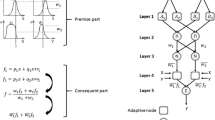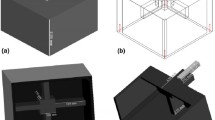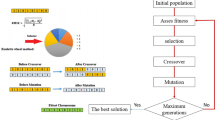Abstract
A proper and reliable estimation of bearing capacity of thin-walled foundations is of importance and necessary for accurate design of these structures. This study proposes a new hybrid intelligent technique, i.e., adaptive neuro-fuzzy inference system (ANFIS)–polynomial neural network (PNN) optimized by the genetic algorithm (GA), called ANFIS–PNN–GA, for prediction of bearing capacity of the thin-walled foundations. In fact, in ANFIS–PNN–GA system, GA was used to optimize the ANFIS–PNN structure. To achieve the aim of this study, a series of data samples were collected from literature. After establishing the database, many ANFIS–PNN–GA models were constructed and proposed to estimate the bearing capacity of the aforementioned foundations. To show capability of this advance hybrid model, two pre-developed models i.e., ANFIS and PNN were also built to predict bearing capacity. The performance prediction of the proposed models were evaluated through the use of several performance indices, e.g., correlation coefficient (R) and mean square error (MSE). The R values of (0.9825, 0.9071, and 0.9928) and (0.8630, 0.7595 and 0.9241) were obtained for training and testing data of the ANFIS, PNN and ANFIS–PNN–GA, models, respectively. Accordingly, because of the role of GA as a practical optimization algorithm in improving the efficiency of both PNN and ANFIS models, results obtained by the ANFIS–PNN–GA model are more accurate compared to other implemented methods. The proposed advance hybrid model can be introduced as a new and applicable technique for solving problems in field of geotechnics and civil engineering.


















Similar content being viewed by others
Abbreviations
- ANFIS:
-
Adoptive neuro-fuzzy inference system
- BC:
-
Bearing capacity
- ICA:
-
Imperialist competitive algorithm
- PNN:
-
Polynomial neural network
- FS:
-
Fuzzy system
- ANN:
-
Artificial neural network
- TS:
-
Takagi–Sugeno
- GA:
-
Genetic algorithm
- BP:
-
Back-propagation
- MF:
-
Membership function
- GUI:
-
Graphical user interface
- PSO:
-
Particle swarm optimization
- AI:
-
Artificial intelligence
- FIS:
-
Fuzzy inference system
- B :
-
Footing width
- IBS:
-
Industrialized building system
- D10 :
-
Grain size
- D50 :
-
Mean grain size
- Cu:
-
Coefficient of uniformity
- Lw/B:
-
Thin-wall length to footing width ratio
- LVDT:
-
Linear variable displacement transducer
- Qu:
-
Maximum bearing capacity
- φ :
-
Soil internal friction angle
- ϒ :
-
Soil unit weight
- MSE:
-
Mean square error
- R :
-
Correlation coefficient
- RMSE:
-
Root mean square error
- Error StD:
-
Error-standard deviation
References
Momeni E, Maizir H, Gofar N, Nazir R (2013) Comparative study on prediction of axial bearing capacity of driven piles in granular materials. J Teknol Sci Eng 61:15–20. https://doi.org/10.11113/jt.v61.1777
Fattah MY, Shlash KT, Mohammed HA (2014) Bearing capacity of rectangular footing on sandy soil bounded by a wall. Arab J Sci Eng 39:7621–7633
Thakur A, Dutta RK (2020) Experimental and numerical studies of skirted hexagonal footings on three sands. SN Appl Sci. https://doi.org/10.1007/s42452-020-2239-9
Tripathy S (2013) Load carrying capacity of skirted foundation on sand. National Institute of Technology, Rourkela
Khatri VN, Debbarma SP, Dutta RK, Mohanty B (2017) Pressure-settlement behavior of square and rectangular skirted footings resting on sand. Geomech Eng 12:689–705
Saleh NM, Alsaied AE, Elleboudy AM (2008) Performance of skirted strip footing subjected to eccentric inclined load. EJGE 13:1–33
Momeni E, Nazir R, Armaghani DJ, Sohaie H (2015) Bearing capacity of precast thin-walled foundation in sand. Proc Inst Civ Eng Eng 168:539–550
Rezaei H, Nazir R, Momeni E (2016) Bearing capacity of thin-walled shallow foundations: an experimental and artificial intelligence-based study. J Zhejiang Univ A 17:273–285
Haider L, Mekkiyah HM (2018) Response of skirted foundations resting on dry medium dense sand. Civ Eng J 4:1193–1205
Jawad FW, Al-Ameri AFI, Yasun AS (2019) Experimental investigation of skirt footing subjected to lateral loading. Open Civ Eng J 13(1):20–25
El Wakil AZ (2010) Horizontal capacity of skirted circular shallow footings on sand. Alexandria Eng J 49:379–385
Wakil AZEL (2013) Bearing capacity of skirt circular footing on sand. Alexandria Eng J 52:359–364
Chandrawanshi S, Kumar R, Kaur DS, Jain DP (2014) Effect of skirt on pressure settlement behaviour of model circular footing in medium dense sand. Int J Adv Eng Technol 5:1–5
Al-Aghbari MY, Mohamedzein Y-A (2004) Model testing of strip footings with structural skirts. Proc Inst Civ Eng Improv 8:171–177
Al-Aghbari MY, Dutta RK (2008) Performance of square footing with structural skirt resting on sand. Geomech Geoengin An Int J 3:271–277
Eid HT, Alansari OA, Odeh AM et al (2009) Comparative study on the behavior of square foundations resting on confined sand. Can Geotech J 46:438–453
Nazir R, Momeni E, Marsono K, Sohaie H (2013) Precast spread foundation in industrialized building system. In: Proceedings of the 3rd International Conference on Geotechnique, Construction Materials and Environment. Nagoya, Japan, pp 13–15
Eid HT (2013) Bearing capacity and settlement of skirted shallow foundations on sand. Int J Geomech 13:645–652
Momeni E, Nazir R, Armaghani DJ, Maizir H (2015) Application of artificial neural network for predicting shaft and tip resistances of concrete piles. Earth Sci Res J 19:85–93
Armaghani D, Momeni E, Abad S (2015) Feasibility of ANFIS model for prediction of ground vibrations resulting from quarry blasting. Environ Earth Sci 74:2845–2860
Mohamad ET, Armaghani DJ, Momeni E et al (2018) Rock strength estimation: a PSO-based BP approach. Neural Comput Appl 30:1635–1646
Momeni E, Nazir R, Armaghani DJ, Mohamad ET (2015) Prediction of unconfined compressive strength of rocks: a review paper. J Teknol 77: 43–50. https://doi.org/10.11113/jt.v77.6393
Momeni E, Armaghani DJ, Hajihassani M, Amin MFM (2015) Prediction of uniaxial compressive strength of rock samples using hybrid particle swarm optimization-based artificial neural networks. Measurement 60:50–63
Bunawan AR, Momeni E, Armaghani DJ, Rashid ASA (2018) Experimental and intelligent techniques to estimate bearing capacity of cohesive soft soils reinforced with soil-cement columns. Measurement 124:529–538
Apostolopoulou M, Asteris PG, Armaghani DJ et al (2020) Mapping and holistic design of natural hydraulic lime mortars. Cem Concr Res 136:106167
Armaghani DJ, Asteris PG, Fatemi SA et al (2020) On the use of neuro-swarm system to forecast the pile settlement. Appl Sci 10:1904
Zhou J, Li X, Mitri HS (2018) Evaluation method of rockburst: State-of-the-art literature review. Tunn Undergr Sp Technol 81:632–659
Zhou J, Li X, Mitri HS (2016) Classification of rockburst in underground projects: comparison of ten supervised learning methods. J Comput Civ Eng 30:4016003
Zhou J, Shi X, Du K et al (2016) Feasibility of random-forest approach for prediction of ground settlements induced by the construction of a shield-driven tunnel. Int J Geomech 17:4016129
Armaghani DJ, Momeni E, Asteris PG (2020) Application of group method of data handling technique in assessing deformation of rock mass. Metaheuristic Comput Appl 1:1–18. https://doi.org/10.12989/mca.2020.1.1.001
Yagiz S, Ghasemi E, Adoko AC (2018) Prediction of rock brittleness using genetic algorithm and particle swarm optimization techniques. Geotech Geol Eng 36:3767–3777
Abdi Y, Momeni E, Khabir RR (2020) A Reliable PSO-based ANN approach for predicting unconfined compressive strength of sandstones. Open Constr Build Technol J 14(1):237–249
Momeni E, Yarivand A, Dowlatshahi MB, Armaghani DJ (2020) An efficient optimal neural network based on gravitational search algorithm in predicting the deformation of geogrid-reinforced soil structures. Transp Geotech 20:100446. https://doi.org/10.1016/j.trgeo.2020.100446
Momeni E, Poormoosavian M, Mahdiyar A, Fakher A (2018) Evaluating random set technique for reliability analysis of deep urban excavation using Monte Carlo simulation. Comput Geotech 100:203–215
Kardani N, Zhou A, Nazem M, Shen S-L (2020) Estimation of bearing capacity of piles in cohesionless soil using optimised machine learning approaches. Geotech Geol Eng 38:2271–2291
Kardani N, Zhou A, Nazem M, Shen S-L (2020) Improved prediction of slope stability using a hybrid stacking ensemble method based on finite element analysis and field data. J Rock Mech Geotech Eng 13(1):188–201
Huang J, Wang QA (2021) Influence of crumb rubber particle sizes on rutting, low temperature cracking, fracture, and bond strength properties of asphalt binder. Mat Struct. https://doi.org/10.1617/s11527-021-01647-4
Dehghanbanadaki A, Sotoudeh MA, Golpazir I et al (2019) Prediction of geotechnical properties of treated fibrous peat by artificial neural networks. Bull Eng Geol Environ 78:1345–1358
Dehghanbanadaki A, Khari M, Amiri ST, Armaghani DJ (2020) Estimation of ultimate bearing capacity of driven piles in c–φ soil using MLP-GWO and ANFIS-GWO models: a comparative study. Soft Comput. https://doi.org/10.1007/s00500-020-05435-0
Harandizadeh H, Armaghani DJ (2020) Prediction of air-overpressure induced by blasting using an ANFIS-PNN model optimized by GA. Appl Soft Comput 99:106904
Zhou J, Li X, Mitri HS (2015) Comparative performance of six supervised learning methods for the development of models of hard rock pillar stability prediction. Nat Hazards 79:291–316
Zhou J, Asteris PG, Armaghani DJ, Pham BT (2020) Prediction of ground vibration induced by blasting operations through the use of the Bayesian Network and random forest models. Soil Dyn Earthq Eng 139:106390. https://doi.org/10.1016/j.soildyn.2020.106390
Zhou J, Qiu Y, Zhu S et al (2020) Estimation of the TBM advance rate under hard rock conditions using XGBoost and Bayesian optimization. Undergr Sp. https://doi.org/10.1016/j.undsp.2020.05.008
Zhao X, Fourie A, Qi C (2019) An analytical solution for evaluating the safety of an exposed face in a paste backfill stope incorporating the arching phenomenon. Int J Miner Metall Mater 26:1206–1216
Qi C (2020) Big data management in the mining industry. Int J Miner Metall Mater 27:131–139
Zhao X, Fourie A, Qi C (2020) Mechanics and safety issues in tailing-based backfill: a review. Int J Miner Metall Mater 27:1165–1178
Zhao X, Fourie A, Veenstra R, Qi C (2020) Safety of barricades in cemented paste-backfilled stopes. Int J Miner Metall Mater 27:1054–1064
Huang J, Duan T, Zhang Y et al (2010) Predicting the permeability of pervious concrete based on the beetle antennae search algorithm and random forest model. Adv Civ Eng 2020:8863181. https://doi.org/10.1155/2020/8863181
Huang J, Sun Y, Zhang J (2021) Reduction of computational error by optimizing svr kernel coefficients to simulate concrete compressive strength through the use of a human learning optimization algorithm. Eng Comput. https://doi.org/10.1007/s00366-021-01305-x
Huang J, Kumar GS, Sun Y (2021) Evaluation of workability and mechanical properties of asphalt binder and mixture modified with waste toner. Constr Build Mater 276:122230
Huang J, Zhang J, Ren J, Chen H (2021) Anti-rutting performance of the damping asphalt mixtures (DAMs) made with a high content of asphalt rubber (AR). Constr Build Mater 271:121878
Momeni E, Armaghani DJ, Fatemi SA, Nazir R (2018) Prediction of bearing capacity of thin-walled foundation: a simulation approach. Eng Comput 34:319–327
Nazir R, Momeni EMK et al (2015) Prediction of bearing capacity of thin-walled spread foundation using ICA-ANN predictive model. In: Proceedings of the International Conference on civil, structural and transportation engineering. Ottawa, Ontario, p May 4th, Paper No. 319
Marto A, Hajihassani M, Momeni E (2014) Bearing capacity of shallow foundation’s prediction through hybrid artificial neural networks. Appl Mech Mater 567:681–686 (Trans Tech Publ)
Momeni E, Nazir R, Armaghani DJ, Maizir H (2014) Prediction of pile bearing capacity using a hybrid genetic algorithm-based ANN. Measurement 57:122–131
Nazir R, Momeni E, Hajihassani M (2014) Prediction of spread foundation’s settlement in cohesionless soils using a hybrid particle swarm optimization-based ANN approach. In: International conference on advances in civil, structural and mechanical engineering, London, UK. pp 20–24
Harandizadeh H, Armaghani DJ, Khari M (2019) A new development of ANFIS–GMDH optimized by PSO to predict pile bearing capacity based on experimental datasets. Eng Comput. https://doi.org/10.1007/s00366-019-00849-3
Momeni E, Dowlatshahi MB, Omidinasab F et al (2020) Gaussian process regression technique to estimate the pile bearing capacity. Arab J Sci Eng. 45:8255–8267. https://doi.org/10.1007/s13369-020-04683-4
Jang J-S (1993) ANFIS: adaptive-network-based fuzzy inference system. IEEE Trans Syst Man Cybern 23:665–685
Jang J-S, Sun C-T (1995) Neuro-fuzzy modeling and control. Proc IEEE 83:378–406
Ye J, Dalle J, Nezami R et al (2020) Stochastic fractal search-tuned ANFIS model to predict blast-induced air overpressure. Eng Comput. https://doi.org/10.1007/s00366-020-01085-w
Bonissone PP, Badami V, Chiang KH et al (1995) Industrial applications of fuzzy logic at General Electric. Proc IEEE 83:450–465
Singh R, Kainthola A, Singh TN (2012) Estimation of elastic constant of rocks using an ANFIS approach. Appl Soft Comput 12:40–45
Koopialipoor M, Nikouei SS, Marto A et al (2018) Predicting tunnel boring machine performance through a new model based on the group method of data handling. Bull Eng Geol Environ 78:3799–3813
Farlow SJ (1984) Self-organizing methods in modeling: GMDH type algorithms, vol. 54. CRC Press
Akaike H (1974) A new look at the statistical model identification. In: Selected Papers of Hirotugu Akaike. Springer, pp 215–222
Koza JR (1992) Genetic programming II, automatic discovery of reusable subprograms. MIT Press, Cambridge
Khandelwal M, Armaghani DJ (2016) Prediction of drillability of rocks with strength properties using a hybrid GA-ANN technique. Geotech Geol Eng 34:605–620. https://doi.org/10.1007/s10706-015-9970-9
Qin Y, Langari R, Gu L (2015) A new modeling algorithm based on ANFIS and GMDH. J Intell Fuzzy Syst 29:1321–1329
Villalobos F (2007) Bearing capacity of skirted foundations in sand. VI Congreso Chileno de Geotecnia, Valparaiso
Momeni E (2015) Bearing capacity of thin-wall spread foundation in cohesionless soil. Ph.D dissertation. Universiti Teknologi Malaysia (UTM), Malaysia.
Khari M, Kassim KA, Adnan A (2014) Sand samples’ preparation using mobile pluviator. Arab J Sci Eng 39:6825–6834
Harandizadeh H, Toufigh MM, Toufigh V (2019) Application of improved ANFIS approaches to estimate bearing capacity of piles. Soft Comput 23:9537–9549. https://doi.org/10.1007/s00500-018-3517-
Harandizadeh H, Toufigh MM, Toufigh V (2018) Different neural networks and modal tree method for predicting ultimate bearing capacity of piles. Iran Univ Sci Technol 8:311–328
Harandizadeh H, Armaghani DJ, Mohamad ET (2020) Development of fuzzy-GMDH model optimized by GSA to predict rock tensile strength based on experimental datasets. Neural Comput Appl 32:14047–14067. https://doi.org/10.1007/s00521-020-04803-z
Armaghani DJ, Mirzaei F, Shariati M et al (2020) Hybrid ANN-based techniques in predicting cohesion of sandy-soil combined with fiber. Geomech Eng 20:191–205
Armaghani DJ, Kumar D, Samui P et al (2020) A novel approach for forecasting of ground vibrations resulting from blasting: modified particle swarm optimization coupled extreme learning machine. Eng Comput. https://doi.org/10.1007/s00366-020-00997-x
Author information
Authors and Affiliations
Corresponding authors
Additional information
Publisher's Note
Springer Nature remains neutral with regard to jurisdictional claims in published maps and institutional affiliations.
Rights and permissions
About this article
Cite this article
Jahed Armaghani, D., Harandizadeh, H. & Momeni, E. Load carrying capacity assessment of thin-walled foundations: an ANFIS–PNN model optimized by genetic algorithm. Engineering with Computers 38 (Suppl 5), 4073–4095 (2022). https://doi.org/10.1007/s00366-021-01380-0
Received:
Accepted:
Published:
Issue Date:
DOI: https://doi.org/10.1007/s00366-021-01380-0




